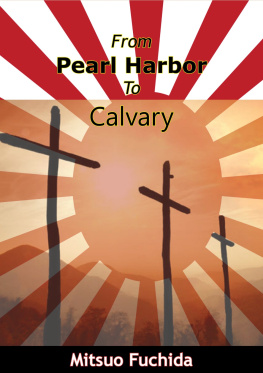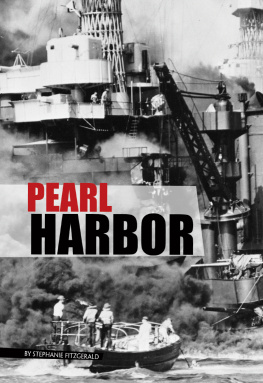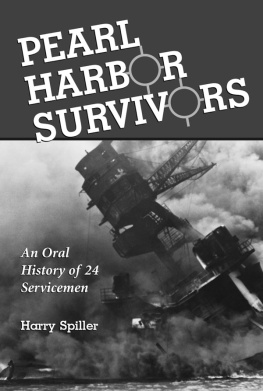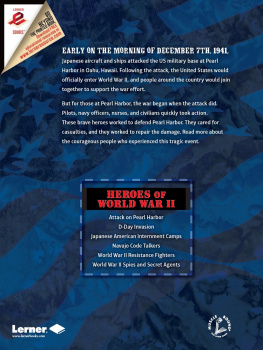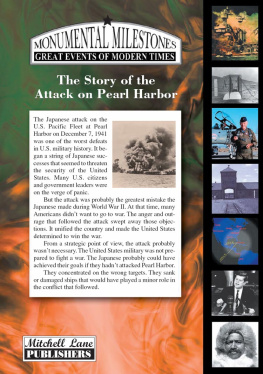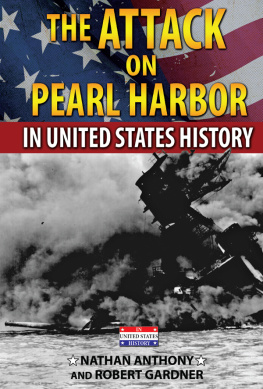

This edition is published by PICKLE PARTNERS PUBLISHINGwww.pp-publishing.com
To join our mailing list for new titles or for issues with our books picklepublishing@gmail.com
Or on Facebook
Text originally published in 1961 under the same title.
Pickle Partners Publishing 2016, all rights reserved. No part of this publication may be reproduced, stored in a retrieval system or transmitted by any means, electrical, mechanical or otherwise without the written permission of the copyright holder.
Publishers Note
Although in most cases we have retained the Authors original spelling and grammar to authentically reproduce the work of the Author and the original intent of such material, some additional notes and clarifications have been added for the modern readers benefit.
We have also made every effort to include all maps and illustrations of the original edition the limitations of formatting do not allow of including larger maps, we will upload as many of these maps as possible.
FROM PEARL HARBOR TO GOLGOTHA
BY
MITSUO FUCHIDA
TABLE OF CONTENTS
Contents
DEDICATION
With appreciation to John Anderson Barbour
for invaluable editorial assistance
With grateful acknowledgement for the use of material in I LED THE ATTACK ON PEARL HARBOR in the United States Naval Institute proceedings, Annapolis, Md.
CHAPTER ONEI Bomb Pearl Harbor
The Akagi pitched and rolled under my feet in the rough sea. White surf whipped across the flight deck in startling contrast to the predawn blackness. The crews were hard pressed to keep their planes from sliding into the sea. The time was 5:30 A.M. The day was the seventh of December. The year, 1941. I climbed to the commander in chiefs quarters.
I am ready for the mission, I reported.
Admiral Nagumo stood to his feet. He grasped my hand hard in his.
Fuchida, he said, I have confidence in you.
Together we entered the dim light of the briefing room where the pilots were waiting. The room was crowded, and some of the men were waiting. The room was crowded, and some of the men were standing in the passageway craning their necks to see me as I stood before a blackboard on which were written the positions of ships in Pearl Harbor.
On that board also was the time0600 hours, and the day7 December.
After I had called the men to attention, Captain Hasegawa gave us our final briefing. Then he said:
Take off according to plan.
The crews scrambled to their places. I climbed to the command post above the flight deck. The operations officer, Genda, put his hand on my shoulder. He did not speak. He just smiled at me. I knew what was in his mind.
Air Officer Masuda questioned me about the pitch and roll of the ship. Would the weather delay at the last minute the plans that had been laid so carefully over the past months?
I reassured him. If we can co-ordinate the take-offs with the pitching deck, well be all right, I said. Then I saluted and left. My plane was in position, its tail striped with red and yellow to mark it as the commanders.
Just before I got into the plane, the officer in charge of the maintenance gang came over to me with a white hachimaki , a cloth headband. I could just make out his smile in the dim light.
Its a gift from the maintenance crews, he said. We want you to take it to Pearl Harbor.
I shook his hand and tucked the band into my flying cap.
The engines warming up were a full-throated roaring chorus in my ears. Suddenly, a green lamp was swung in a circle at the end of the flight deck. It was the signal for the take-off. As it was released, the first plane moved forward. It gained speed. I held my breath wondering if the pilots timing would be right. Then I breathed easier as it was airborne.
Another followed...and another...and another...out into the blackness.
Fifteen minutes later, 183 fighter-bombers and torpedo planes had taken off from the flight deck of six aircraft carriers. This was the first wave of the total 359 planes, which I led into Pearl Harbor. We were 230 miles due north of Oahu Island and Pearl Harbor.
This was the culmination of my every waking thought since the day, September 24, 1941, when Commander Genda had taken me aside at Kagoshima on the southern tip of Kyushu and said, Dont be alarmed, Fuchida, but we want you to lead our air force in the event that we attack Pearl Harbor!
My heart was still pounding with the excitement of the proposal when Genda took me on board the Akagi for conference with the first air fleet commander, Vice-Admiral Chuichi Nagumo and his staff including the chief of staff, Rear Admiral Ryunosuke Kusaka. In that conference, Commander Genda urged the use of torpedoes against the ships in Pearl Harbor.
But thats impossible, I protested. The water depth in Pearl harbor only averages about thirty-two feet.
Genda insisted that if we could find a way to torpedo the ships in such shallow water, it would add to the surprise of the attack by its very unexpectedness. Besides, the torpedoes below the surface would do more effective damage than bombings from the air.
So at last I had agreed to find a way. And I had only two and a half months. Indeed, less than that, because that day I learned that December was the month planned for the attack. Although officially we spoke of If we attack... we all thought, When we attack...
In the weeks that followed I had stepped up the pace of training which was difficult to do because we did not want American observers to notice any undue activity on our part.
Early in November, I licked the torpedo problem. We added more fins to our torpedoes and planned to drop them from a height of fifty-two feet instead of the usual three hundred or more.
And now December 7 was here, and our air armada was airborne. We flew through heavy clouds for forty-five minutes. Then I turned on the radio-direction finder and picked up the Honolulu radio station. As I listened to a program of light music, I adjusted the antenna and found we were five degrees off course. I corrected this. As I continued to listen, I heard the announcer give the weather report.
Averaging partly cloudy, with clouds mostly over the mountains. Cloud base at 3500 feet. Visibility good. Wind north at ten knots an hour.
We could not have asked for better weather!
0730 HoursTime to deploy for attack. We were over Kahuku Point, the northernmost tip of the island, and still no indication that anyone knew we were in the air. We had two plans for the attack.
If we had the advantage of surprise, the torpedo planes were to strike first. Then the level bombers were to attack the air bases. In case of resistance, the dive-bombers were to attack first to confuse and attract the enemy fire. Then the level bombers would bomb and destroy the aircraft guns. Finally, the torpedo planes would attack the ships at anchor in the harbor.
0740 HoursI gave the signal for a surprise attack. The dive-bombers rose to 4000 meters, and the level bombers hung just below the clouds.
0749 HoursI gave the order. My radio man tapped out the codeTo, to, to, to...Notify whole squadron to plunge to attack!
0755 Hoursthe dive bombers, led by Lieutenant Commander Tahahashi, attacked Hickam Field, Ford Island, and Wheeler Field.
0757 HoursLieutenant Commander Murata and his torpedo planes attacked the battleships in the harbor.
0800 HoursIn single-file formation, the fighter planes strafed the air bases.
Next page
